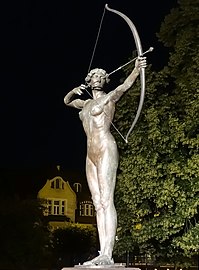|
Jan Kochanowski Park, Bydgoszcz
Jan Kochanowski Park is a green area covering 3,15 ha, located in downtown Bydgoszcz, Poland. It is part of the "Music district in Bydgoszcz" (Polish: Dzielnica muzyczna w Bydgoszczy) and is named after the Polish renaissance poet, Jan Kochanowski. LocationThe park is located in an area urbanized at the beginning of the 20th century. The park is rectangular, with dimensions 120 × 250 m, and is delineated by the following avenues: Due to the proximity of several musical institutions (Pomeranian Philharmonic, Polish Theatre in Bydgoszcz, Bydgoszcz Music Academy, Music Schools Group), as well as the outdoor gallery of monuments of composers and virtuoso, the park and its surroundings are called Music district in Bydgoszcz. History   The park has been designed by Konrad Neumann, then director of the Municipal gardens of Bromberg in 1901; its initial surface was 2.8 hectares (28,000 m2). It was part of urban plans laid out in 1903, and developed through 1911[1] The design was inspired from English gardens, with about 80 species of trees and ornamental trees, mainly endemical native species.[2] The main entrance was located at Bismark Platz, today at the junction between Słowackiego and January 20, 1920, streets. The northern edge on Bulöw Straße (Adam Mickiewicz Alley) was a lawn planted with roses and low shrubs.[3] In January 1920, Bydgoszcz joined the re-created state of Poland. On July 31, 1927, a ceremony unveiled in the park the monument to Henryk Sienkiewicz, first of its kind in the country. In 1938, a survey in registered 84 species of trees and shrubs including:[3] white birch, common hawthorn, alders, sweet chestnuts, silver berry, common salt trees, walnut trees, magnolias, jasmines, poplars, silver poplars, cherry trees, English oaks, robinias, sumacs, elder berries, willows, lime trees, elms, balsam trees, firs, white firs, sawara cypresses, Norway spruces, blue spruces, mountain pines, pine trees, Swiss pines, English yews, ashleaf maples, ailanthus, sycamores, Norway maples, field maples, silver maples, horse-chestnuts, horse-chestnuts, beeches, European beeches, hornbeams and European hornbeams. In particular, the park boasted elms and poplars 25 meters tall high and oaks with 300 to 480 cm circumference trunks.[3] After World War II and the destruction of part of the trees, new plantings have been carried out in the post-war years. In 1952, during the construction of the Pomeranian Philharmonic hall, four 400 cm-perimeter oaks were cut down.[3] In 1958, the southern limit of the park has been extended to include the area of the Philharmonic. In 1960, in the northern part of the park, the statue The Archer, one of Bydgoszcz icons, was installed to a dedicated rectangular square. In 2014, an overhaul of Jan Kochanowski Park has been performed, to highlight its historical character and link it with the Music District.[4] This works included:[5]
Renovation costed 4.8 million Polish złoty.[5] The newly refurbished park was open on August 13, 2015[7] The re-construction of the park happened at the same time as the re-building of the new "son et lumière fountain" before the Pomeranian Philharmonic building, launched on May 23, 2014).[8] Since its creation, the park bore the following names:[9]
Park namesake is Jan Kochanowski (1530–1584), a famous Polish Renaissance poet. MonumentsJan Kochanowski park stands out among other city green areas as welcoming a large number of monuments. First one, Henryk Sienkiewicz monument by Konstanty Laszczka, was unveiled in 1927, in presence of thousands of spectators, officials and the president of Poland Ignacy Mościcki. The memorial was destroyed by Nazis in September 1939, a new statue has been realized in May 1968, by Stanisław Horno-Popławski.
Since 1960, The Archer, realized in 1910 by Ferdinand Lepcke, has moved to Jan Kochanowski Park. It is one of the most valuable public sculpture in Bydgoszcz and considered as a real symbol of the city.
In 1970, a monument portraying a broken rose, designed by Józef Makowski, was set up in the park. It commemorates the death of fifty pupils from the High School for boys, killed by Nazis on September 5, 1939.[10]
In 2007, the statue by Michał Kubiak of Andrzej Schwalbe (1923–2002), first director of the Pomeranian Philharmonic is present on the square facing the building.
Outdoor gallerySource:[11] In addition, the park hosts an outdoor collection of sculptures of outstanding personages of classical music. It features 16 monuments (10 statues and 6 busts) of composers and virtuoso musicians, and placed here progressively since the early 1970s:
SpeciesThe park displays a mix of native species (oak, hornbeam, beech tree, sycamore) and alien species (red beech and white horse chestnut). Moreover, one can notice red horse-chestnuts and European beeches (purple variety and cone variety)[12] Nearby the Pomeranian Philharmonic building stand red horse-chestnuts and umbrella hornbeam. In the same way, abutting the Main building of Bydgoszcz Music Academy grow silver maples, a large English oaks and rare conifer species (Douglas-fir, eastern white pine and savin juniper).[12] In the park are registered 21 species, making it the second most rich park in Bydgoszcz, with regards to vegetal variety. Polish Natural Monuments in Jan Kochanowski Park and its surroundings[13][14]
Gallery
See alsoWikimedia Commons has media related to Jan Kochanowski Park in Bydgoszcz.
References
Bibliography
|
||||||||||||||||||||||||||||||||||||||||||||||||||||||||||||||


































